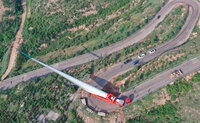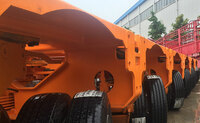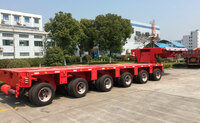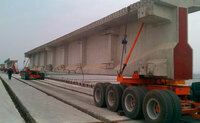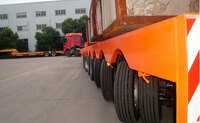BLADE LIFTER
Product Quick Detail
- FOB Price
- USD $500,000.00 / Piece
- Minimum Order
- 1
- Place Of Origin
- china
- Packaging
- N/A
- Delivery
- 15 Days
Specifications
After the rapid development of the wind energy market in recent years, the wind energy resources in plain areas with good construction conditions have almost been developed. At present, wind turbine heavy haul transport carriers are being transported to the mountainous area and sea with difficult construction conditions. However, the mountain roads are narrow and the turning radius is small.
In order to effectively avoid the collision between the wind blade and the mountain, the wind blade must be transported in an inclined state. Therefore, Rui trailer\'s blade lifter for wind turbine appears in the market, and will greatly help for a transport company for the such area to use.
BLADELIFTER SPECIFICATIONS
Dimention: 10420*3400*3865mm
Lifting angle: 0-36 degree
Lifting mode: duel cylinder lifting
Rotate mode: 4 motor drive
Rotate of blade: 2 motor drive
Control: manual+wireless control
Counterweight size: 1600*1400mm
Shifting distance: 0-4000mm
Shifting mode: duel cylinder push
Weighing mode: 4 point weight
Capacity: 510 ton*m
Deadweight: 47,000kgs
HOW DOES BLADE LIFTER TRANSPORT WORK?
Generally, in order to make the wind blade avoid obstacles more effectively, it is also necessary to make the blade rotate horizontally 360 °, so a slewing bearing is set between the bladelifter and the slewing platform. However, when the blade lifter lifts the blade, the center of gravity of the blade rises upward and moves to one side of the blade lifter. If the blade lifter wind turbine of the distance from the vertical line passing through the center of gravity of the wind blade to a certain point and the weight of the wind blade is the blade gravity distance, the gravity distance of the wind blade relative to the slewing bearing changes during the lifting process of the wind blade.
In other words, the balance condition of the blade lifter is different under the horizontal and lifting state of the wind blade. This brings a problem, that is, if it is designed so that the upper part above the slewing bearing is balanced when the wind blade is lifted by a certain angle, such as 30 ° (the center of gravity of the upper part is on the axis of the slewing bearing), the blade can rotate 360 ° when the blade is lifted by 30 ° or near, but if the blade is placed horizontally, one side of the blade is too heavy. When in 360 ° rotation, the blade lifter transport can easily turn over to one side of the wind blade. If the upper part is designed to be balanced when the wind blade is placed horizontally, it can rotate 360 ° when the wind blade is placed horizontally. However, if the wind blade is lifted at a certain angle, such as 30 °, one side of the counterweight is too heavy. When turning 360 °, the blade lift is easy to overturn to one side of the counterweight.
However, it is inevitable that the center of gravity will rise when lifting the wind blade. Therefore, how to make the center of gravity of the upper part only rise while the gravity distance relative to the slewing bearing remains basically unchanged or changes as little as possible is the problem that the blade lifter needs to solve.
The simplest blade lifter is to hinge a swing frame on the rotary platform, set a pitch slewing bearing between the swing frame and the transition plate, fix the wind blade on the transition plate, and push the swing frame to swing around the hinge fulcrum through the lifting oil cylinder, which can lift the wind blade transport upward at a certain angle.
At present, blade lifter in this special market mainly adopts three technical ways to solve this problem. First, increase the weight of the whole unit so that the weight of the rotating platform, blade lifter, and wind blades, which change the weight of the loaded heavy moment, is relatively small so that the change of the heavy moment of the whole unit is relatively small during the lifting process; The second method is to set the movable counterweight, that is, set the movable counterweight on the rotary platform, and move the counterweight automatically or manually while lifting the wind blade, so that the center of gravity of the upper part is basically maintained on the axis of the rotary bearing; The third is the method of moving the blade lifter, that is, setting a sliding slider and chute to make the blade lifter slide to one side of the slewing bearing while lifting the wind blade, so as to keep the center of gravity of the upper part basically on the axis of the slewing bearing.
WHY CHOOSE RUI TRAILER AS YOUR BLADE LIFTER TRANSPORT SUPPLIER?
Blade lifters for wind power plants frequently present haulage companies with a difficult task. Especially when dealing with the \"last mile\", transport is often more difficult particularly when tight corners or obstacles have to be negotiated. It is precisely in these situations that the new blade rotator from Ruiqianhe provides the right solution to avoid obstacles such as trees or buildings with the rotor blades even more effectively. Also on steep hills or narrow winding mountainous roads, the position of the rotor blade can be adapted to the route without any time loss. The blade rotator can be mounted and transported on a pulled platform trailer combination and guarantees flexible transportation of rotor blades from different manufacturers through the quick-release plate and thus maximum efficiency and cost-effectiveness in daily use.
The angle of inclination up to 60°
Max. rotation angle of the rotor blade +-180°
Maximum stability due to a hydraulically-operated, sliding counterweight in longitudinal and horizontal directions depending on the rotor blade position
Operating temperature – 20 °C up to + 40 °C
BLADE LIFTER ADVANTAGES
A blade lifter is a wind turbine blade transport trailer that is used to lift and move heavy blades, such as those used in wind turbines, gas turbines, and steam turbines. Some of the advantages of using blade lifters include:
Increased Safety: Bladelifters are designed to lift heavy and awkwardly shaped objects safely and efficiently. By using a blade lifter, the risk of injury to workers is greatly reduced.
Improved Efficiency: Blade lifters are designed to work quickly and efficiently, which can reduce the amount of time needed to move and install heavy blades. This can help reduce downtime and increase productivity.
Increased Precision: Blade lifters are designed to provide a high degree of precision when lifting and moving heavy blades. This can help ensure that the blades are properly positioned and aligned, which can help improve the performance of the turbine.
Reduced Cost: By reducing the amount of time needed to move and install heavy blades, blade lifters can help reduce the overall cost of maintenance and repair for turbines.
Versatility: Blade lifters are designed to work with a wide range of blade sizes and shapes, making them versatile tools for the maintenance and repair of different types of turbines.
HOW ARE WIND TURBINE BLADES TRANSPORTED WITH BLADELIFTER
Wind turbine blades can be transported with a blade lifter wind turbine, which is a specialized hydraulic windmill blade transport designed to transport wind turbine blades in an upright position. Here\'s how it works:
Preparation: The Bladelifter is brought to the wind turbine site and set up next to the turbine tower. The blade is detached from the rotor hub and prepared for transport.
Attachment: The blade lifter transport\'s hydraulic arms are extended to lift the blade off the ground and support it in an upright position. The arms are then attached to the blade using specially designed clamps.
Transport: The Bladelifter slowly moves forward, transporting the blade in an upright position. The hydraulic arms adjust to changes in the terrain, ensuring that the blade remains stable and secure during transport.
Installation: Once the blade reaches its destination, the Bladelifter positions the blade and lowers it into place on the rotor hub. The blade is then secured to the hub, and the Bladelifter is detached.
The Bladelifter is a safe and efficient way to transport wind turbine blades, reducing the risk of damage during transport and installation. It also allows for transport on narrow roads and in areas with limited clearance.
BLADE LIFTER KEY FEATURES
During wind blade transportation, the wind blade can lift, leveling and rotate itself to avoid various obstacles such as trees, mountains and wires, and effectively solve the problem of wind power blade transportation in mountainous areas.
The blade is directly fix to the blade lifter and lifted in midair to transport the super long blade with a short total length of trailer. During transportation, the hydraulic control can make the wind blade rotate 360 °, the wind blade can rotate 360 ° through the lower slewing bearing and annular slide, and the maximum opening angle of the wind blade is 60 ° through the expansion and contraction of the oil cylinder, which can reduce the counter weight added.
During transportation, if the wind is strong, the wind blade can rotate 360 degrees to avoid the wind, and participate in the balance through counterweight to ensure transportation safety.
If you want to know more kinds of heavy haulage trailers, please visit our website.
- Country: China (Mainland)
- Founded Year: 2010
- Address: Address:41-421,no.1818,lianhang road,shanghai
- Contact: jerome hsu

